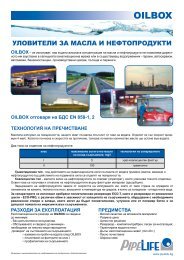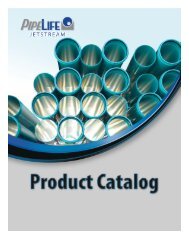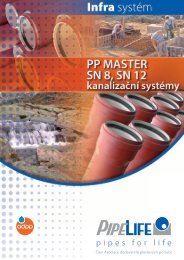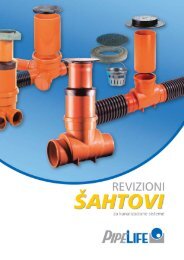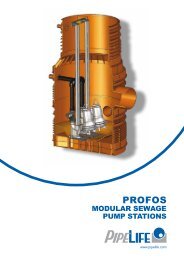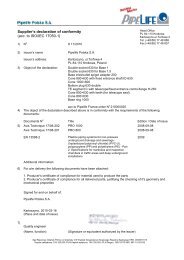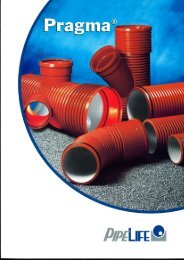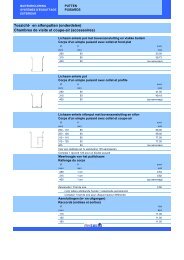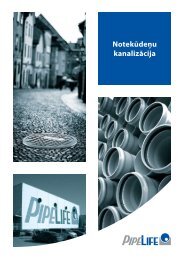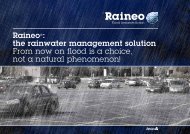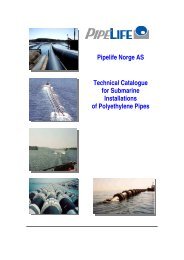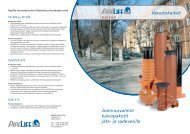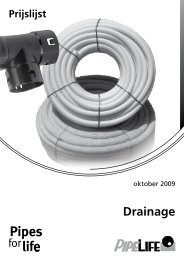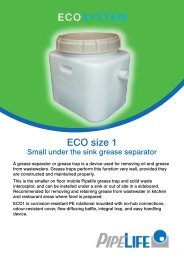Design manual
Design manual
Design manual
You also want an ePaper? Increase the reach of your titles
YUMPU automatically turns print PDFs into web optimized ePapers that Google loves.
13. Operation of the infiltration system<br />
14. Standard requirements<br />
An infiltration system should undergo periodic<br />
inspections. Settling chambers must be<br />
checked for the amount of debris collected. It<br />
is recommended that the chambers should be<br />
inspected every six months and the collected<br />
debris periodically removed.<br />
Stormbox infiltration boxes have 6 inspection<br />
openings 110, 160 mm in diameter and 2<br />
openings 110, 160 and 200 mm in diameter to<br />
enable the insertion of cleaning equipment and<br />
CCTV.<br />
Underground infiltration systems require periodic<br />
inspections – at least once a year.<br />
Such inspections should be carried out before<br />
periods of frost.<br />
Underground systems should be for example:<br />
Protected from leaves and other debris,<br />
Kept at a suitable distance from trees<br />
(to protect the boxes from damage by<br />
developing root systems),<br />
Infiltration boxes should be rinsed,<br />
Mechanical pre-treatment devices should<br />
undergo maintenance. Approx. every 6<br />
months check the amount of debris in the<br />
setting tank and remove as necessary.<br />
13.2. Operation in winter<br />
Underground rainwater infiltration systems are<br />
generally resistant to reduced infiltration in<br />
winter. Minimum cover layer above the boxes<br />
should be preserved, according to the ground<br />
freezing depth in the area. Additionally boxes<br />
are covered with a layer of LECA at least 20 cm<br />
in depth.<br />
The risk of flooding in freezing temperatures is<br />
slight, as torrential rains very rarely fall on frozen<br />
ground. The maximum rate of snow melting is 2<br />
mm/h, much less than the runoff of a standard<br />
design rainfall.<br />
The following requirements should be met when<br />
installing Stormbox infiltration systems:<br />
PN-EN 1610:2002 Construction and inspection<br />
of sewage systems;<br />
PN-ENV 1046:2007 Plastic pipeline systems<br />
– Outdoor water and sewage systems –<br />
Overground and underground installation<br />
practices;<br />
PN-EN 1295-1:2002 Static calculations for<br />
ground-buried pipelines at various load<br />
conditions. Part 1: General requirements;<br />
PN-B-10736:1999 Ground work. Open<br />
excavations for water and sewage systems.<br />
Technical conditions of work;<br />
“Technical conditions of the construction<br />
and commissioning of sewage systems”.<br />
Technical requirements of COBRTI INSTAL.<br />
Booklet 9. Editor: COBRTI INSTAL/Information<br />
Centre. Installation Technology in<br />
Construction, June 2003<br />
ATV-A 118E “Hydraulic Dimensioning and<br />
Verification of Drainage Systems”.<br />
DWA-A 138 “Planung, Bau und Betrieb<br />
von Anlagen zur Versickerung von<br />
Niederschlangswasser”.<br />
DIN 1989-1 “Rainwater harvesting systems –<br />
Part 1: Planning, installation, operation and<br />
maintenance”.<br />
DIN 1989-3 “Rainwater harvesting systems –<br />
Part 3: Collecting tanks for rainwater”.<br />
ISSO 70-1 “Omgaan met hemelwater binnen<br />
de perceelgrens”.<br />
BRL 52250 “Kunsttstof infiltratiesysttemen voor<br />
hemelwater”.<br />
DWA A-117 Bemessung von<br />
Regenrückhalteräumen.<br />
Regulation of the Minister of Transport and<br />
Marine Economy of 2 March 1999 on the<br />
technical conditions to be fulfilled by public<br />
roads and their location (Poland)<br />
42<br />
43



